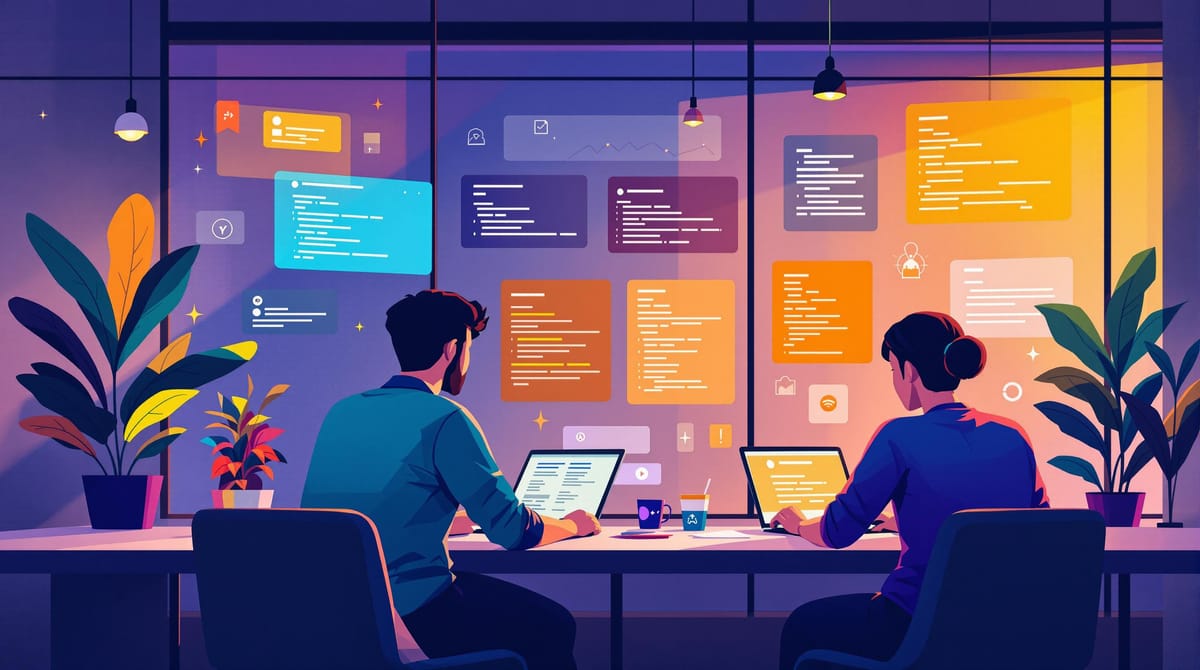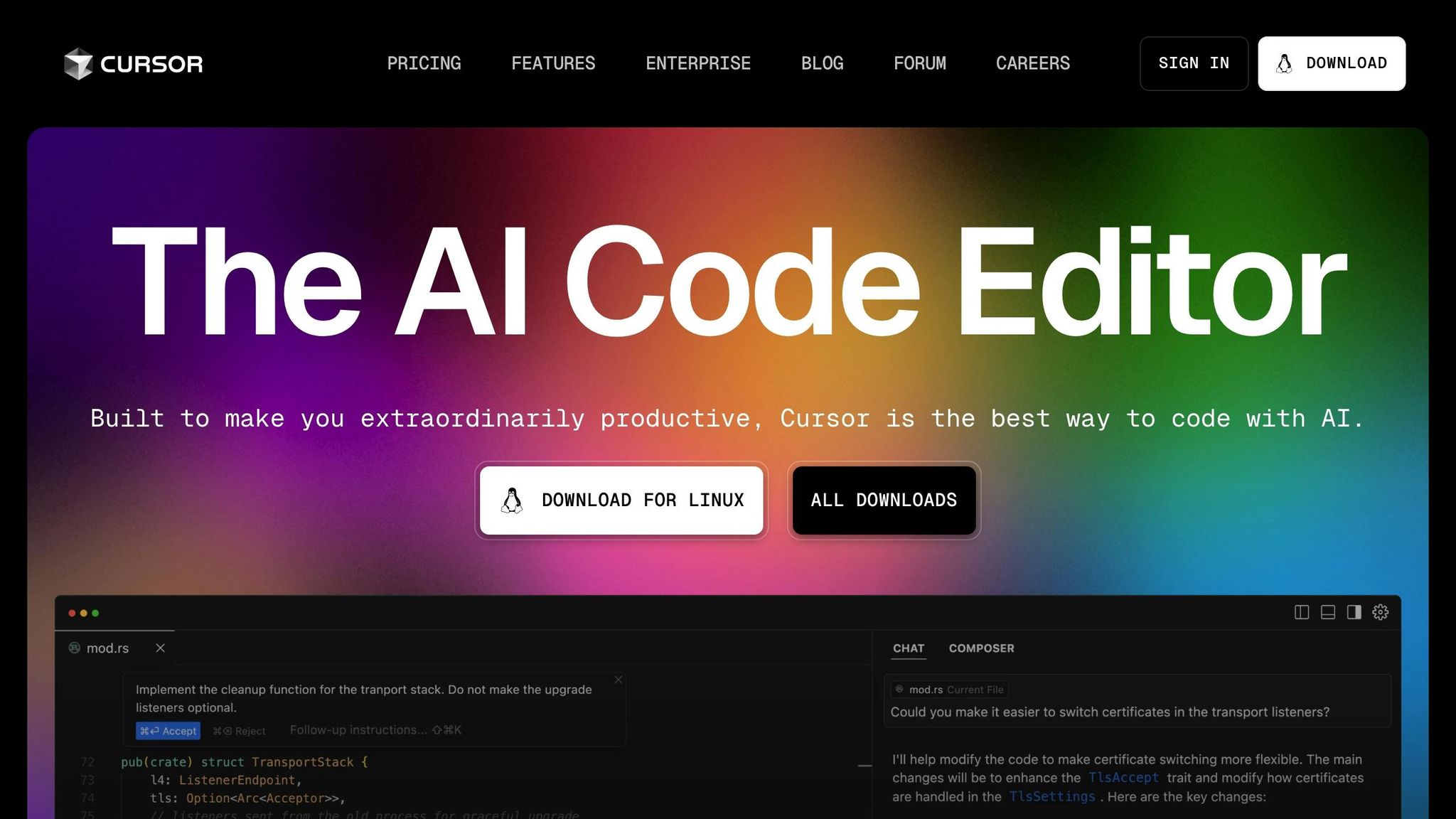Vibe Coding: The AI-Driven Revolution in Software Development
Explore how vibe coding, driven by AI, transforms software development by enhancing accessibility, speed, and team productivity.

Vibe coding is changing how software is built. It uses AI to turn plain English into functional code, making development faster, simpler, and more accessible. Introduced in February 2025 by Andrej Karpathy, this method allows developers to focus on ideas rather than manual coding.
Key Takeaways:
- Faster Development: AI automates repetitive tasks, speeds up prototyping, and simplifies debugging.
- Accessibility for Non-Programmers: Domain experts without coding experience can now contribute to projects.
- Smaller Teams, Bigger Output: AI tools enable small teams to achieve the productivity of larger groups.
- Popular Tools:
- GitHub Copilot: Best for professional coding with context-aware suggestions.
- Cursor: Great for debugging and learning with plain language explanations.
- Replit: Ideal for prototyping and collaboration in a browser-based environment.
- Risks: Developers must ensure code quality, address security vulnerabilities, and maintain programming fundamentals.
Vibe coding is reshaping industries like gaming, healthcare, and education by making software development more efficient and inclusive. To stay ahead, developers need skills in prompt engineering, AI code evaluation, and system integration.
Technical Overview
Basic Process
Vibe coding uses AI to turn natural language inputs into code. Here's how it works step by step:
- Natural Language Processing: Breaks down user input to identify requirements and programming concepts.
- Context Analysis: Examines the project's structure to ensure the code fits its architecture.
- Code Generation: Creates code snippets or full functions based on the input.
- Validation and Testing: Runs automated checks to catch syntax errors, security risks, and performance issues.
This process speeds up development by automating repetitive tasks, letting developers focus on more complex challenges.
Popular Tools
Several platforms lead the way in AI-assisted development, each offering distinct features:
| Tool | Key Features | Best Used For |
|---|---|---|
| GitHub Copilot | Instant suggestions, VS Code integration, context-aware completions | Large projects, professional coding |
| Cursor | Inline explanations, multi-file refactoring, plain language debugging | Debugging, learning programming |
| Replit | Browser-based coding, collaborative tools, instant deployment | Prototyping, educational projects |
For example, Cursor's plain language debugging lets developers describe bugs in simple terms and get precise fixes, saving valuable time. These tools are trained on real-world codebases, enabling them to produce high-quality, industry-ready code.
That said, developers should always review the output carefully. These tools are designed to assist, not replace, human expertise in software development.
Changes to Software Development
Speed and Output
Vibe coding speeds up development by automating repetitive tasks. It allows for quick prototyping, generates code efficiently, and simplifies debugging. This makes it easier to test and refine solutions, increasing productivity while opening the door for more people to contribute.
Access for Non-Programmers
Vibe coding makes software development more accessible by allowing people without formal training to create functional programs. This approach has attracted newcomers from various fields, like business and content creation, into the world of software development. With this influx of diverse contributors, team dynamics and structures are shifting.
Team Size and Output
Thanks to streamlined workflows, smaller teams can now use AI-assisted coding to match the output of larger groups. The focus has moved from writing extensive amounts of code to strategic planning, improving user experiences, and driving innovation. This shift allows teams to prioritize high-level goals over routine tasks.
Karpathy Vibe Coding Full Tutorial with Cursor (Zero Coding)

Risks and Limitations
Vibe coding offers plenty of potential, but it also comes with its own set of challenges.
Code Quality
AI-generated code often handles standard patterns well but can stumble when it comes to edge cases or intricate scenarios. While the code might look correct on the surface, subtle logical errors can creep in, only becoming apparent during testing. AI models also tend to falter when faced with unexpected inputs. Because of this, developers need to prioritize comprehensive testing, use automated reviews, and engage in peer evaluations to ensure the code meets quality standards.
Security Risks
Security remains a major concern in vibe coding. AI models can unintentionally replicate existing vulnerabilities or even introduce new ones into production environments. Developers need to take proactive steps to mitigate these risks.
| Measure | Approach | Outcome |
|---|---|---|
| Code Scan | Vulnerability detection | Spot flaws before deployment |
| Access Control | Enforce strict permissions | Block unauthorized changes |
| Dependency Check | Perform regular audits | Maintain security compliance |
Skill Development
With the rise of vibe coding, developers are focusing more on solving higher-level problems, but that doesn't mean programming fundamentals are any less important. To succeed, developers must combine deep technical knowledge with AI expertise. This allows them to adjust AI-generated code, identify errors, and decide when to rely on AI tools versus traditional coding methods.
To stay ahead, developers should sharpen both their traditional coding skills and their AI capabilities. Striking this balance ensures they can tackle complex challenges while maintaining the expertise needed to create reliable software.
Looking Ahead
Changes in Education
Programming education is evolving to include concepts like AI-assisted development. Academic programs now emphasize areas such as AI management and prompt engineering. This shift is transforming how students learn and apply their skills:
| Skill Area | Old Approach | New Approach |
|---|---|---|
| Code Writing | Manual syntax | Prompt engineering |
| Problem Solving | Algorithm design | System architecture |
| Testing | Unit testing | Evaluating AI-generated outputs |
| Documentation | Code comments | Writing natural language specs |
New Developer Skills
The role of developers is changing with vibe coding. Instead of focusing solely on manual coding, developers are now expected to manage AI-driven processes. Key skills in demand include:
- Prompt engineering: Writing precise and effective instructions for AI systems
- Output evaluation: Reviewing AI-generated code for accuracy and reliability
- System integration: Merging AI components with existing platforms
- Risk assessment: Identifying security and performance issues tied to AI-generated outputs
This shift highlights how developers are adapting to new workflows and responsibilities.
Other Industry Uses
Vibe coding is influencing industries outside traditional software development. In gaming, developers are testing ways to use everyday language to design gameplay mechanics. Creative teams are exploring methods to turn narrative descriptions into interactive digital elements. Meanwhile, the healthcare industry is looking into how natural language inputs can simplify the creation of specialized software for medical professionals.
This approach is reshaping how digital solutions are created across various sectors.
Conclusion
Main Points
Vibe coding has reshaped software development in three major ways:
- Faster Development: AI-powered tools now allow smaller teams to work at a pace previously achievable only by larger groups.
- Greater Accessibility: Tools like Replit, Cursor, and GitHub Copilot make it possible to create functional software using natural language instructions.
- Changing Roles: Developers are now more focused on managing AI systems, ensuring quality, and planning strategic implementations, rather than writing code line by line.
Next Steps
To stay ahead in this AI-driven development era, professionals need to build new skills while refining existing ones. Here's how the skillset is evolving:
| Area | Traditional Skills | AI-Driven Skills |
|---|---|---|
| Code Creation | Writing syntax manually | Crafting prompts & guiding AI |
| Quality Control | Reviewing code | Validating AI-generated outputs |
| Architecture | Designing systems | Planning AI integration |
| Security | Testing vulnerabilities | Assessing AI-specific risks |
Mastering both AI-driven techniques and core programming knowledge is key to thriving in this new environment. Upskillist offers courses that cover both areas, helping you stay prepared to lead in this rapidly changing field.

